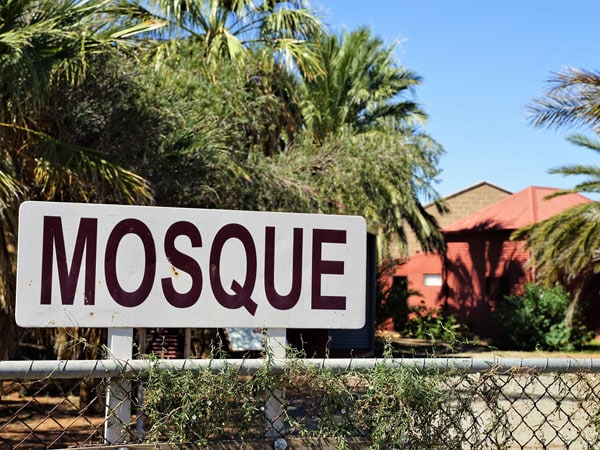The astonishing story of Broken Hill’s tiny cameleer mosque spans the outback, oceans and generations, as Steve Madgwick discovers.
You won’t see fleets of grey nomads parked outside the curious brown corrugated shed at the end of a palm-flanked gravel driveway on the petering northern fringes of Broken Hill. Perhaps because the outback-spanning sagas that radiated from Broken Hill Mosque mostly fell outside the white-settler ‘Aussie’ narrative, lucky to receive even a cursory mention in our highschool history lessons.
The Broken Hill Mosque Museum is located on the corner of Williams and Buck streets. To see inside the museum, you have to contact 82-year-old curator and caretaker Amanullah Shamroze. Bobby, as he’s been called for as long as he can remember, unlocks the door and, in doing so, unshackles the story of Broken Hill’s ‘Afghan’ cameleers.
The mosque was built in 1891. (Image: Steve Madgwick)
The son and grandson of outback-building camel drivers, Bobby’s insight is rare and precious indeed. From the 1860s, the cameleers and their camels were shipped into Australia’s interior from India, Afghanistan and beyond. They became the backbone of the pre-railway outback transportation network, playing under-rewarded roles in building continent-traversing projects such as the Trans-Australian Railway and the Adelaide to Darwin Overland Telegraph Line.
The mosque functions as a museum. (Image: Steve Madgwick)
The story behind the ‘Afghan Mosque’
The ‘Afghan Mosque’ was considered the spiritual hub of the cameleer camp that mushroomed on Broken Hill’s peripheries, just as the frontier town in far-western NSW was establishing itself as a key outpost in the crossroads of outback Australia. Because the cameleers lived on the fringes of society, however, the facts of their stories have been bent and stretched by time.
“Some say the mosque was built in 1883, others say 1887, and I’ve also heard 1891, too,” says Bobby of Australia’s oldest surviving ‘Ghan-town’ mosque. “I’m not quite sure, but it’s somewhere between those figures.”
Outside stands a vintage camel-drawn wagon, the semitrailer of its day, which may have even hauled the mosque’s corrugated iron inland from the coast. Past a small channel for ceremonial feet washing, a memorabilia-rich antechamber leads into the prayer room, with its faded mint-green pressed-metal walls, two rows of prayer mats and pair of Qurans resting on ornate wooden stands.
The Prayer Room offers insights into Broken Hill history. (Image: Steve Madgwick)
Pioneer worshippers
Bobby’s father, Shamroze Khan, and grandfather, Fazulla Ziadulla, worshipped here. But the rest of their wayfaring lives are hard to pin down. “Strangely, Dad never ever said where he actually came from, never mentioned any family. Even my grandfather said nothing about him really.”
Bobby knows more about Grandpa’s story. Among surviving black-and-white photographs is one showing Fazulla outside his old house in the Punjab city of (then) Campbellpur, India (which became Attock, Pakistan, after the 1947 partition). He has been told that his father and grandpa came out together to Australia, but Bobby believes they arrived on different ships.
Bobby (Amanullah) Shamroze shares snapshots of his storied life. (Image: Steve Madgwick)
Grandpa’s boat apparently docked in Fremantle, while his father’s first stop was either Port Pirie, South Australia, or Port Albert, Victoria. “It must have been [Dad’s] first stop because he [met] his first woman down there. She was a governess, apparently, at some property. They must have got on together and took off together.”
Bobby’s father would buy camels “off the boat” in Port Augusta and then walk them 400 kilometres east to Broken Hill. “There was no other way to get them there. When they were building the railway line between Port Augusta and Marree [SA], he and a team carted all the water and shifted the camps.”
Broken Hill is home to some of Australia’s toughest terrain. (Image: Destination NSW)
His dad apparently stashed enough cash as a camel dealer to buy “seven or eight houses” in Broken Hill “back when you could get one for 200 pounds.” But Bobby didn’t fare so well, especially after his mum left when he was just four. He blames his parents’ split on the age difference: 62 (dad) versus 24 (mum) when Bobby was born.
“It was a bit rough after Mum went. I ran away a few times. When I was seven or eight, I jumped on the train to Adelaide to look for Mum. I’d been down there with my father visiting the Adelaide Mosque. You could go for a month and no one would worry about you. Not like today. And I’d always have a couple of bob on me, to buy a pie or something.”
Emus on parade in Broken Hill. (Image: Destination NSW)
The rise of cameleers in town
Bobby bounced around for a while, sporadically staying with his mum (who he found working in a pub) and going to school in Adelaide. When his dad died in 1950, “welfare grabbed him”, before a relative eventually helped Bobby return to Broken Hill.
He lived with his grandfather briefly, before becoming a shearer and wool-presser out on a remote station, settling back into ‘the Hill’ in the mid-1960s with life partner Janet, lured by work in the mines.
There were about 400 cameleers living in Broken Hill in the early 1900s. (Image: Destination NSW)
After four decades as a place of worship, the mosque began to lose its worshippers in the late 1920s, as trains and trucks made camel transport redundant. Of the estimated 100 cameleers in town, many returned to the subcontinent, while others found work on stations, as tradesmen or in the mines (as Bobby’s dad and grandpa also did).
After Broken Hill’s last practicing Muslim passed away, the mosque became little more than a cubbyhouse for local kids, eventually “rescued” by the Broken Hill Historical Society in and made into a museum a year later. Bobby agreed to be its custodian 12 years ago, under the condition that “they do a few things”, such as putting up fences around the property.
The Broken Hill Mosque is built on a former camel camp. (Image: Steve Madgwick)
A familial connection with the mosque
“There was no one left to do it, and I’d collected a lot of information. But since then, I’ve had three operations so they’re worrying about me dying.” Bobby’s connection with the mosque has always been more familial than spiritual. “I’m a ‘bush Baptist’. When I was in the boys’ home, I went to a different church every week. I don’t even follow the language, but I’m here to keep the history and try to get a bit of a name for the old camel drivers who worked this country.”
Bobby’s brother and sister are gone now, and he’s “outlived” his mum’s family, too. He’s willing to pass on the mosque responsibilities to any of his three children or seven grandchildren but “only if they want to do it”.
For now, every time Bobby gets a call from a visitor or occasionally someone wanting to pray, the octogenarian travels the couple of kilometres from home to retell his stories, to the best of his recollection. He holds the photo of Grandpa close to him; a window into the indistinct past, and a tactile memory that might just help “keep the cameleer legacy alive for another generation.”
The post The incredible story behind the tiny Broken Hill Mosque appeared first on Australian Traveller.




